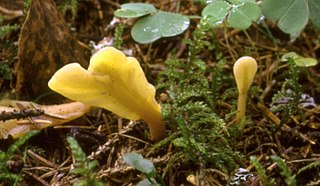
Spathularia flavida, commonly known as the yellow earth tongue, the yellow fan, or the fairy fan, is an ascomycete fungus found in coniferous forests of Asia, Europe and North America. It produces a small, fan- or spoon-shaped fruit body with a flat, wavy or lobed cream to yellow colored "head" raised on a white to cream stalk. The height is usually approximately 2–5 cm, and up to 8 cm. The fungus fruits on the ground in mosses, forest duff or humus, and fruit bodies may occur singly, in large groups, or in fairy rings. The spores produced by the fungus are needle-like, and up to 95 micrometres long. Several varieties have been described that differ largely in their microscopic characteristics. S. flavida has been described by authorities variously as inedible, of unknown edibility, or edible but tough.

Hydnellum peckii is a fungus in the genus Hydnellum of the family Bankeraceae. It is a hydnoid species, producing spores on the surface of vertical spines or tooth-like projections that hang from the undersurface of the fruit bodies. It is found in North America, Europe, and was recently discovered in Iran (2008) and Korea (2010). Hydnellum peckii is a mycorrhizal species, and forms mutually beneficial relationships with a variety of coniferous trees, growing on the ground singly, scattered, or in fused masses.

Hydnellum is a genus of tooth fungi in the family Bankeraceae. Widely distributed in the Northern Hemisphere, the genus contains around 40 species. The fruitbodies of its members grow by slowly enveloping nearby bits of grass and vegetation. There is great variability in the form of Hydnellum fruitbodies, which are greatly influenced by environmental conditions such as rainfall and humidity, drying winds, and temperature. They are too tough and woody to eat comfortably. Several species have become the focus of increasing conservation concern following widespread declines in abundance.
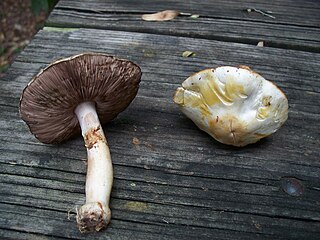
Agaricus abruptibulbus is a species of mushroom in the genus Agaricus. It is commonly known as the abruptly-bulbous agaricus or the flat-bulb mushroom. First described by the mycologist Charles Horton Peck, this bulbous-stemmed edible species smells slightly of anise or bitter almond, and turns yellow when bruised or cut. The mushroom is medium-sized, with a white, yellow-staining cap on a slender stipe that has a wide, flat bulb on the base.

Phellodon is a genus of tooth fungi in the family Bankeraceae. Species have small- to medium-sized fruitbodies with white spines on the underside from which spores are released. All Phellodon have a short stalk or stipe, and so the genus falls into the group known as stipitate hydnoid fungi. The tough and leathery flesh usually has a pleasant, fragrant odor, and develops a cork-like texture when dry. Neighboring fruitbodies can fuse, sometimes producing large mats of joined caps. Phellodon species produce a white spore print, while the individual spores are roughly spherical to ellipsoid in shape, with spiny surfaces.

Hydnellum aurantiacum is an inedible fungus, commonly known as the orange spine or orange Hydnellum for its reddish orange or rusty red colored fruit bodies. Like other tooth fungi, it bears a layer of spines rather than gills on the underside of the cap. Due to substantial declines in sightings, this species is listed as critically endangered in the United Kingdom.

Geopyxis carbonaria is a species of fungus in the genus Geopyxis, family Pyronemataceae. First described to science in 1805, and given its current name in 1889, the species is commonly known as the charcoal loving elf-cup, dwarf acorn cup, stalked bonfire cup, or pixie cup. The small, goblet-shaped fruitbodies of the fungus are reddish-brown with a whitish fringe and measure up to 2 cm across. They have a short, tapered stalk. Fruitbodies are commonly found on soil where brush has recently been burned, sometimes in great numbers. The fungus is distributed throughout many temperate regions of the Northern Hemisphere. It is found in Europe, Turkey, and North America. Although it is primarily a saprotrophic species, feeding on the decomposing organic matter remaining after a fire, it also forms biotrophic associations with the roots of Norway spruce.

Helvella acetabulum is a species of fungus in the family Helvellaceae, order Pezizales. This relatively large cup-shaped fungus is characterized by a tan fruit body with prominent branching ribs resembling a cabbage leaf; for this reason it is commonly known as the cabbage leaf Helvella. Other colloquial names include the vinegar cup and the brown ribbed elfin cup. The fruit bodies reaches dimensions of 8 cm (3.1 in) by 4 cm (1.6 in) tall. It is found in Asia, Europe, and North America, where it grows in sandy soils, under both coniferous and deciduous trees.

Butyriboletus appendiculatus is an edible pored mushroom that grows under oaks and other broad leaved trees such as beech. It is commonly known as the butter bolete. It often grows in large colonies beneath the oak trees, and is frequently found cohabiting with old oaks in ancient woodland. It is relatively rare in Britain. Its stipe and pores are often bright yellow and its flesh stains bright blue when cut or bruised.
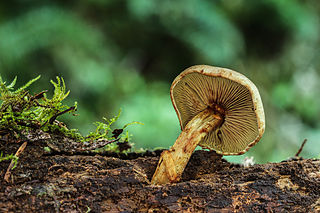
Gymnopilus punctifolius is a species of mushroom in the family Hymenogastraceae found in North America.

Hydnellum ferrugineum, commonly known as the mealy tooth or the reddish-brown corky spine fungus, is a species of tooth fungus in the family Bankeraceae. A widely distributed species, it is found in north Africa, Asia, Europe, and North America. The fungus fruits on the ground singly or in clusters in conifer forest, usually in poor or sandy soil. Fruit bodies are somewhat top-shaped, measuring 3–10 cm (1–4 in) in diameter. Their velvety surfaces, initially white to pink, sometimes exude drops of red liquid. The lower surface of the fruit body features white to reddish-brown spines up to 6 mm long. Mature fruit bodies become dark reddish brown in color, and are then difficult to distinguish from other similar Hydnellum species. H. ferrugineum forms a mat of mycelia in the humus and upper soil where it grows. The presence of the fungus changes the characteristics of the soil, making it more podzolized.

Morchella punctipes is a species of morel fungus in the family Morchellaceae. It is native to North America, found widely distributed east of the Rocky Mountains. It is edible when cooked.

Phellodon tomentosus, commonly known as the zoned cork hydnum, is a species of tooth fungus in the family Bankeraceae. First described as Hydnum tomentosum by Carl Linnaeus in 1753, it was transferred to the genus Phellodon by Howard James Banker in 1906. It is found in Asia, Europe, and North America.

Sarcodon atroviridis is a species of fungus in the family Bankeraceae found in North America and Asia. It was originally described in 1895 as Hydnum atroviride by Andrew Price Morgan. Howard James Banker transferred it to Sarcodon in 1906. The fungus is known from Asia and North America; in 2015 it was reported from Brazil. The specific epithet atroviridis means "blackish green". While not explicitly known to be poisonous, it is considered of poor edibility.
Hydnellum complicatum is a tooth fungus in the family Bankeraceae. Found in North America, it was described as new to science by mycologist Howard James Banker in 1906 from collections made in New York. Banker, who described the fruitbody as "irregular and complicated", considered it closely related to H. floriforme, differing in its reddish color and smaller spores.
Hydnellum earlianum, commonly known as Earl's hydnum, is a tooth fungus in the family Bankeraceae found in North America. It was described as new to science in 1906 by Howard James Banker from collections originally made in Georgia. The specific epithet honors mycologist Franklin Sumner Earle, "whose excellent field notes have frequently aided in the discrimination of species in this family".
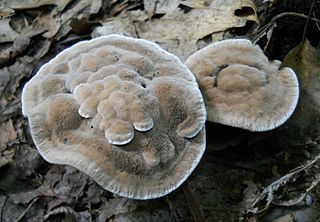
Hydnellum spongiosipes, commonly known as the velvet tooth, is a tooth fungus in the family Bankeraceae. It is found in Europe and North America. In Switzerland, it is considered a vulnerable species.
Phellodon putidus is a species of tooth fungus in the family Bankeraceae. Found in North America, it was first described scientifically by George F. Atkinson as Hydnum putidum in 1900. Howard James Banker transferred it to the genus Phellodon in 1906.
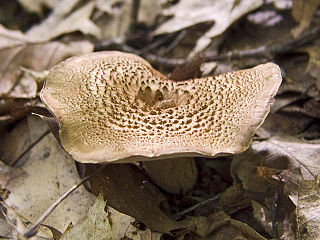
Hydnellum underwoodii is an inedible species of tooth fungus in the family Bankeraceae. Found in North America, it was described as new to science in 1906 by American mycologist Howard James Banker. Its reddish-brown, convex to flattened cap measures 5–14 cm (2.0–5.5 in) in diameter. Reddish-brown, partially erect scales adorn the cap surface. Spines on the cap underside are 1–3 mm long; they are initially white, becoming brown with grayish tips in age. The oval to spherical spores are 6–7.5 by 5.5–6.5 µm. The fungus fruits singly or scattered, on the ground in coniferous forests.
Sarcodon scabripes is a species of fungus in the family Bankeraceae found in Asia, Europe, and North America. It was originally described in 1897 as Hydnum scabripes by Charles Horton Peck. Howard James Banker transferred it to the genus Sarcodon in 1906. The fungus makes fruit bodies with a drab gray to flesh-colored cap, and flesh that is white. In addition to the United States, where it was first documented, S. scabripes has been reported from Japan and the Sverdlovsk Oblast region of Russia.














